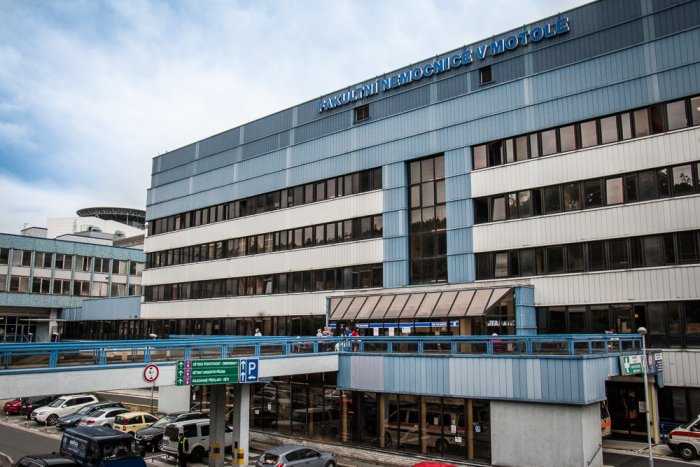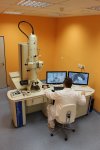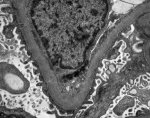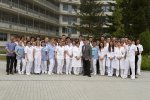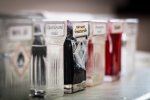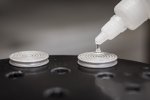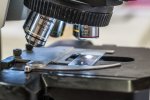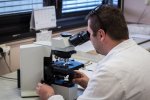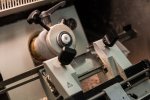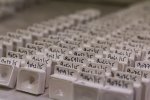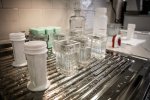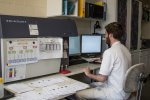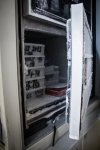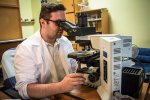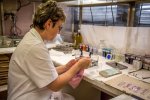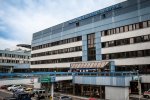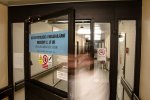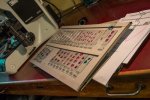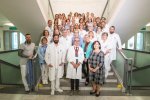- Basic information
- Management and staff
- Lymphoma group
- Laboratory of Neuropathology
- Biopsy station
- Documents to download
- For the professional public
- History
- Gallery
- Contact
Basic information
The Department of Pathology and Molecular Medicine deals with complex laboratory diagnostics of cancer and non-cancerous diseases. It uses methods classical histology and cytology with subsequent special laboratory examination methods. These include: view of cells and tissues at the level of ultrastructural analysis (electron microscopy), evidence of protein expressionimmunohistochemical methods, Western blot, flow cytometry), demonstration of enzyme activity in tissue sectionsenzyme histochemistry), analysis of changes at the level of chromosomes and genes and detection of some viruses in histological section (in situ hybridization methods) and analysis of DNA and RNA extracted from tissues (methods of qualitative and quantitative polymerase chain reaction, sequencing). Investigated biological the material is tissues (native, frozen, fixed), bone marrow punctures, peripheral blood, possibly other cellular fluids (effusions) and autologous grafts for bone marrow transplantation.
The main task in healthcare is ensuring diagnostics and typing of diseases operated or in whom cell or tissue samples have been taken by a non-surgical approach (endoscopic sampling, needle punctures, cell smears) at the University Hospital in Motol. Part of the examination takes place within the so-called perioperative biopsies performed during the operation and the result of which influences the operator's decision on the further course of the operation. Part of the examinations performed at the workplace is used to forecasting certain diseases, controlling the disease response to treatment, or k indication for targeted specific therapy patients. Autopsy operation The workplace performs an educational and control function within the University Hospital in Motol and the 2nd Medical Faculty of Charles University in Prague.
The workplace also focuses on consulting activity with a wider scope in the Czech Republic, especially for the diagnosis of childhood tumors, for the diagnosis of diseases lymphatic tissues (generally for lymphomas and lymphoproliferative diseases) and for bone marrow disease in histological tissue processing. Other areas of specialization of the workplace are: diagnostics of kidney diseases, diagnostics muscular diseases and disorders of the nervous system - at the histopathological level with the use of specialized laboratory procedures, diagnostics of congenital malformations, especially the cardiovascular system.
Teams of trained workers - doctors and biologists with the help of specialized laboratory technicians deal with the diagnosis of diseases of various systems laboratories.
Teaching activity The institute is summarized on the website 2nd Faculty of Medicine. Our workplace is accredited for postgraduate training of doctors and histological laboratory technicians.
Research activities The Department of Pathology and Molecular Medicine focuses mainly on the areas of childhood tumors, lymphatic tissue diseases (lymphomas and lymphoproliferative conditions) and on areas of the muscles and nervous system. In its research activities, the department cooperates with the clinics of the 2nd Faculty of Medicine and the University Hospital in Motol, with the Institute of Neurosciences, Charles University, 2nd Faculty of Medicine and with the Institute of Molecular Genetics of the ASCR. Within the framework of international cooperation, a long-term relationship is established with the following institutions: Department of Pathological Anatomy and Consultation Center for Biopsy Diagnostics of Hematopoietic Diseases Jessenius Faculty of Medicine in Martin, Comenius University in Bratislava and Martin University Hospital a Department of Neuropathology, Stanford University, Palo Alto, CA, USA.
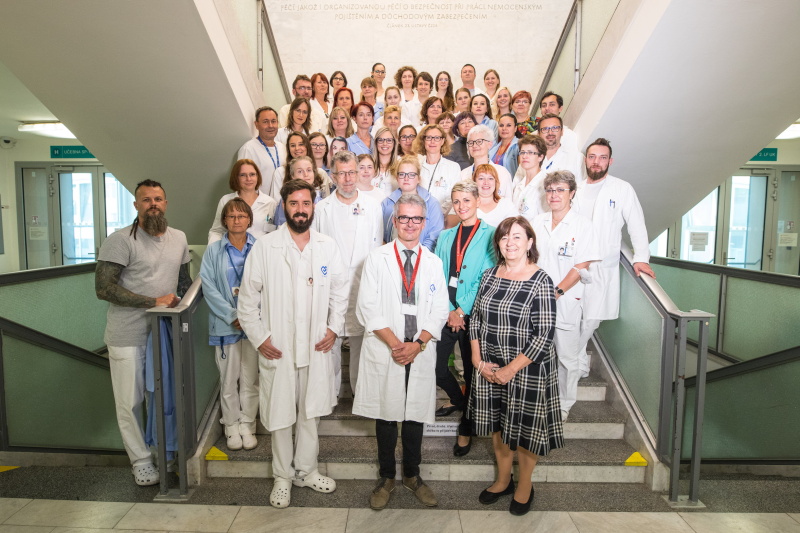
Introduction to the Department of Pathology and Molecular Medicine, 2nd Faculty of Medicine, Charles University and Motol University Hospital
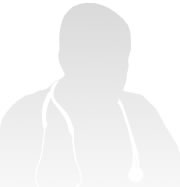
Primary
Prim. MUDr. Petr Skapa, Ph.D.
Contact the primary
(224) 435 623
Other contacts
Chief laboratory assistant
(224) 435 626
Secretariat
224 435 601, 224 435 601
patologie@fnmotol.cz
Management and staff
Knowledge
The head
Prof. MD Josef Zámečník, Ph.D.
tel .: (224) 435 635
Primary
MUDr. Petr Skapa, Ph.D.
tel .: (224) 435 623
Chief laboratory assistant
Vladimíra Kratinová
tel .: (224) 435 626
Secretariat
Petra Poděbradská
tel .: (224) 435 601
fax: (224) 435 620
Email: patologie@fnmotol.cz, patologie@lfmotol.cuni.cz
Perioperative biopsy: (224) 435 615
Personnel
Physicians and specialists - naturalists: | |
| MD Jan Balko | (224) 435 624 |
| MUDr. Vit Campr | (224) 435 619 |
| MUDr. Linda Capkova, Ph.D. | (224) 435 658 |
| MUDr. Pavel Fuccillo | (224) 435 631 |
| MD Marek Grega | (224) 435 633 |
| MUDr. Jaromír Haček | (224) 435 628 |
| MD Daniela Hamaňová | (224) 435 632 |
| MD Renata Chmelová | (224) 435 630 |
| Mgr. Alena Kalfusova, Ph.D. | (224) 435 622 |
| MUDr. Miroslav Koblízek | (224) 435 645 |
| Prof. MD Roman Kodet, CSc. | (224) 435 657 |
| MD Daniela Nováková Kodetová | (224) 435 639 |
| MD Adéla Kotrbová | (224) 435 631 |
| MD Jakub Kovářík | (224) 435 627 |
| RNDr. Lenka Krsková, Ph.D. | (224) 435 634 |
| MD Katarína Kuťková | (224) 435 627 |
| RNDr. Marcela Mrhalova, Ph.D. | (224) 435 634 |
| MD Lívia Molčanyová | (224) 435 627 |
| MD Jan Soukup | (224) 435 629 |
| RNDr. Jana Szabová, Ph.D. | (224) 435 650 |
| MUDr. Petr Skapa, Ph.D. | (224) 435 623 |
| M.Sc. Jana Včeláková, Ph.D. | (224) 435 658 |
| Prof. MD Josef Zámečník, Ph.D. | (224) 435 635 |
Workers: | THP staff: | |
Adrian Cibula Milada Black Zdenek Fencl Aneta Filipovicova Vlastimila Forejtová Maria Gronská Bc. Irena Krumlovská Hilská Veronika Kejzlarová Vladimíra Kratinová Jana Kůrková Eva Langerová Alexandra Malkusová Petra Merhulíková Filip Mikus Ing. Radka Nagy | Eliška Obešlova Jana Palajová Martina Porembská Simona Pospíšilová Beata Potempová Jindřiška Procházková Romana Skalická Ivana Staňková Helena Stenzlova Sara Škopová Lenka Tibenská Zuzana Tökölyová Petra Toxová Radka Včelná Vera Velíková
| Hana Janevová Renata Kulinkovská Aneta Florinová Svetluše Říhová Uhlichová Jana Zuzana Šimková Petra Poděbradská Auxiliary laboratory technicians:Dana Kočárníková Matěj Kadlec |
Lymphoma group
The informal beginnings of the Lymphoma Group in Pathology at the Motol University Hospital date back to the second half of the 20s, when pathologists from Prague's teaching institutes began to meet to deal with the diagnosis of lymphomas. Complex or interesting and rare cases were discussed with the microscope. Pathological diagnosis of lymphomas is somewhat out of line with other subspecializations in pathology, as the relatively narrow group of tumors in the absolute number of cases consists of a large number of often rare units. In addition, the diagnosis of lymphomas is unthinkable without a wide variety of special tests. The discussion helped with differential diagnostic balances, helped to increase diagnostic certainty in individual cases, and also helped to develop diagnostic methods, especially molecular ones. The friendly and working atmosphere of these meetings was typical.
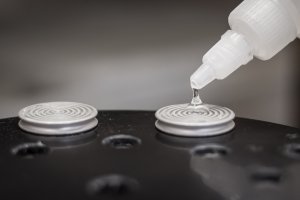 At about the same time, on the initiative of prof. Klenera and doc. The Cooperative Lymphoma Group (KLS or the Czech Lymphoma Study Group, CLSG) was also established at the 1st Internal Clinic of the General Hospital. The participation of pathologists in KLS was understood by our instructed clinical colleagues as a completely natural and integral part of the care of patients with lymphoma, which is also expressed by the guaranteed place of two representatives of the pathological community in the KLS committee.
At about the same time, on the initiative of prof. Klenera and doc. The Cooperative Lymphoma Group (KLS or the Czech Lymphoma Study Group, CLSG) was also established at the 1st Internal Clinic of the General Hospital. The participation of pathologists in KLS was understood by our instructed clinical colleagues as a completely natural and integral part of the care of patients with lymphoma, which is also expressed by the guaranteed place of two representatives of the pathological community in the KLS committee.
After the transfer of dr. From Albert's pathology to Motol, the activities of the Lymphoma Group became more regular. Pathology in Motol, meanwhile, thanks to prof. Kodeta became the first and for a long time the only workplace in the Czech Republic that captured the global trend towards a comprehensive approach to lymphoma diagnosis. Cooperation with KLS continues. Pathologists from Motol participate in individual research programs, dr. Campr is already a member of the KLS Executive Committee in the third term. In the spring of 2008, after years of efforts, a meeting of "lymphomaniacs" from all over the Czech Republic was organized for the first time, first in the premises of Motol pathology, and since October 2008
People in the Lymphoma Group
Diagnosis of lymphomas now deals with prof. Kodet, as. Soukup, dr. Campr and dr. Prouzová. Kodetová also cooperates in the diagnosis of pediatric and cutaneous lymphomas.
We can't imagine our work without immunohistological examination, which is provided mainly by Mrs. Eliška Axmannová and Miss Simona Pospíšilová. Due to the volume of necessary examinations (although it is unbelievable, not only lymphomas are examined immunohistologically ...) it is often necessary to help Mrs. Vlasta Forejtová, Mr. Adrian Cibula and others.
Flow cytometry laboratory led by RNDr. Petra Manďáková, Ph.D., during her absence she is represented by Mgr. Eliška Stránská, Mgr. Jarmila Čandová, Mrs. Jana Palajová and Mrs. Romana Skalická.
In situ hybridization laboratory led by RNDr. Marcela Mrhalova, Ph.D. and Mrs. Vlasta Forejtová cooperates with her.
In the indicated cases, the diagnosis cannot be done without the molecular examination that he performs Lamp - Laboratory of Molecular Pathology - founded as. Soukupem and dr. Dahbi in 1994. Today the laboratory is headed by RNDr. Lenka Krsková, Ph.D. and doc. RNDr. Markéta Kalinová, Ph.D., M.Sc. Alena Augustiňáková and others.
It would be downright unfair to at least not mention all the other workers biopsy station, without which we would not have frozen slices or definitively processed paraffin material, workers from histochemical laboratorieswho manage frozen material and perform some tests for us, and last but not least the ladies from the Registry and the Secretariat, on which hang the necessary but unpopular office work with rewriting, printing and sending out findings, reporting insurance codes, keeping a register of tumors (and that finding our diagnostic test of all specimens and blocks is sometimes a superhuman task!) and in the case of consulting examinations sending the borrowed material.
Laboratory of Neuropathology
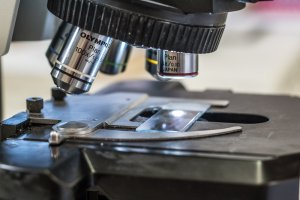 The Laboratory of Neuropathology and Muscle Biopsies (labNP) has been a part of the Institute of Pathology and Molecular Medicine, Charles University, 2nd Faculty of Medicine and Motol University Hospital since 2002. It provides a complete biopsy diagnostic service for neurosurgical and neurological fields, not only at the Motol University Hospital, it also cooperates with rheumatology departments and participates in the diagnosis of neuromuscular metabolic disorders in cooperation with other laboratories.
The Laboratory of Neuropathology and Muscle Biopsies (labNP) has been a part of the Institute of Pathology and Molecular Medicine, Charles University, 2nd Faculty of Medicine and Motol University Hospital since 2002. It provides a complete biopsy diagnostic service for neurosurgical and neurological fields, not only at the Motol University Hospital, it also cooperates with rheumatology departments and participates in the diagnosis of neuromuscular metabolic disorders in cooperation with other laboratories.
Contact:
Department of Pathology and Molecular Pathology, Charles University, 2nd Faculty of Medicine and Motol University Hospital
Material receipt:
Mon-Fri: 7.30-15-XNUMX;
blue building of Motol University Hospital (adult part), node A, 2nd floor;
phone: 224 435 615
Best by appointment with Mr. Cibula (tel. 224 435 636 - muscle biopsies), with Ms. Knotková (tel. 224 435 638 - nerve biopsies), or with prof. Locksmith (tel. 224 435 635).
Detailed information <a href="https://cdn.shopify.com/s/files/1/1932/8043/files/Odstoupeni_od_smlouvy_EN.pdf?v=1595420299" data-gt-href-en="https://en.notsofunnyany.com/">HERE</a>.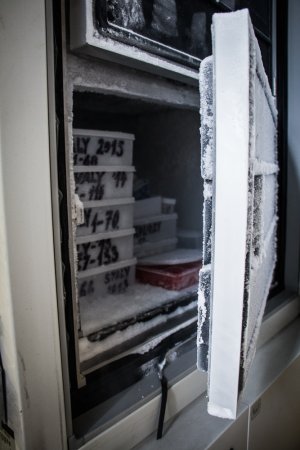
Laboratory of Neuropathology and Muscle Biopsies
V Úvalu 84
15006 Prague 5
Prof. MD Josef Zámečník, Ph.D.
phone: 224 435 635
Email: josef.zamecnik@lfmotol.cuni.cz
Adrian Cibula, chief laboratory assistant of labNP
by phone: 224 435 636
Email: C.Adrian@seznam.cz
Biopsy station
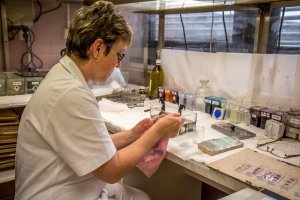 In situ hybridization laboratory
In situ hybridization laboratory
The laboratory deals with specialized diagnostics of malignant tumors in children and adults. The most commonly used method is fluorescence in situ hybridization on interphase nuclei (I-FISH), which allows to determine chromosomal changes typical of individual tumors on histological sections from tissues taken from samples and thus to specify or diagnose.
More details at:
http://www.lf2.cuni.cz/info2lf/ustavy/upa/labor/hybr_l.htm
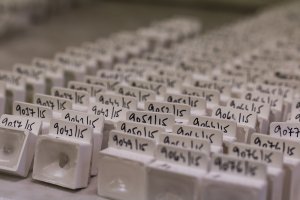 Laboratory of Molecular Pathology (Lamp)
Laboratory of Molecular Pathology (Lamp)
The laboratory focuses on molecular diagnostics of malignant tumors in children and adults and monitoring the results of their treatment (monitoring of minimal residual disease) at the level of nucleic acids (DNA, RNA) isolated from the examined tissues. Lymphomas and sarcomas are at the forefront of the laboratory's interest.
More details at:
http://www.lf2.cuni.cz/info2lf/ustavy/upa/labor/molek_l.htm
Flow cytometry laboratory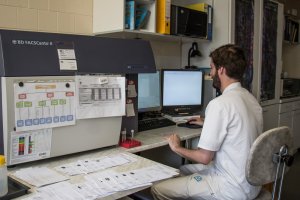
The laboratory deals with immunophenotyping of hematological, especially lymphoid tumors (lymphomas and leukemias) both in natively supplied biopsy samples and in peripheral blood, bone marrow and other body fluids.
More details at:
Documents to download
For the professional public
The Department of Urology of the 2nd Medical Faculty of Charles University and the University Hospital Motol received EBU certification
- EBU Certification Program (887,64 KB)
- EBU Certification (245,06 KB)
Field of pathological anatomy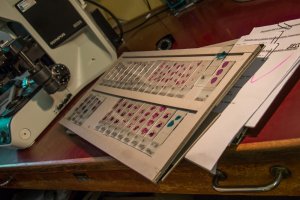
Accreditation according to Act No. 95/2004 Coll. on the conditions for acquiring and recognizing professional competence and specialized competence in the medical profession of doctor, dentist and pharmacist
Contact:
Prof. MD Josef Zámečník, Ph.D.
phone: 224 435 635
Email: josef.zamecnik@lfmotol.cuni.cz
Accreditation is valid until November 17, 11
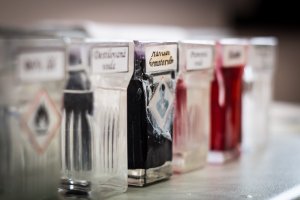 Medical laboratory assistant for histology - practical part
Medical laboratory assistant for histology - practical part
Accreditation of workplaces for specialized education NZO according to Act 96/2004 Coll.
Expert guarantor:
Vladimíra Kratinová
phone: 224 435 626
Email: vladimira.kratinova@fnmotol.cz
Accreditation is valid until November 3, 11
Looking back on 44 years of "pediatric pathology" at the Head Institute
Josef Stejskal
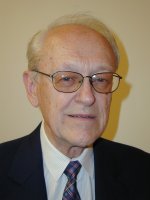 All the more memories and impressions, of course, remained in the memory of those who spent many years of their lives filled with work, sometimes less pleasant, experienced successes and failures, friendships and disputes. All the time I was a direct participant or at least a close observer of the development of "childhood pathology", as the faculty institute was generally called. Therefore, I tried to compile a brief and certainly incomplete overview of the history of the institute from fragments of my memories and to recall some episodes that are less well known today.
All the more memories and impressions, of course, remained in the memory of those who spent many years of their lives filled with work, sometimes less pleasant, experienced successes and failures, friendships and disputes. All the time I was a direct participant or at least a close observer of the development of "childhood pathology", as the faculty institute was generally called. Therefore, I tried to compile a brief and certainly incomplete overview of the history of the institute from fragments of my memories and to recall some episodes that are less well known today.
As is well known, the Faculty of Pediatrics was founded in 1951 as an offshoot of the Faculty of General Medicine and in 1953 it became independent. Her pathology was also initially conceived as a department of the Head of the Institute, whose then head, Professor Heřman Šikl, was said to be quite positive about this issue. The first three years of pediatrics studied pathology under his guidance, and many listeners at the time still remember him with respect. From the winter semester of 1954, the independent teaching of the new faculty, until then operated only in the last three years of study, was extended to the third year, and a separate pathology of the Faculty of Pediatrics was established. Its leader was Šikl's former first assistant, Dagmar Benešová, MD, who was recently habilitated for that purpose, and thus returned to the maternity institution after six years of exile.
and in 1953 it became independent. Her pathology was also initially conceived as a department of the Head of the Institute, whose then head, Professor Heřman Šikl, was said to be quite positive about this issue. The first three years of pediatrics studied pathology under his guidance, and many listeners at the time still remember him with respect. From the winter semester of 1954, the independent teaching of the new faculty, until then operated only in the last three years of study, was extended to the third year, and a separate pathology of the Faculty of Pediatrics was established. Its leader was Šikl's former first assistant, Dagmar Benešová, MD, who was recently habilitated for that purpose, and thus returned to the maternity institution after six years of exile.
However, this note requires further explanation: after the war, the Professor's "Institute for Brain Research" was also located in the Head Institute  Haškovec, personal physician Klement Gottwald and in 1948 chairman of the action committee of the Faculty of Medicine. He was uncomfortable with Šikl's open first assistant, who fearlessly defended the interests of his institute, and therefore pushed for her transfer to the Pilsen branch, where the local comrades needed to put one of the faculty's founders, pathologist Dr Antonín Čech, on the sidelines. Benešová significantly improved teaching and operation, following the example of the Prague Institute, and gained enormous authority among students and doctors with her knowledge and vigorous and fearless demeanor, with which she criticized numerous shortcomings in the life of the faculty and hospital. Although the faculty offered her habilitation and expansion, she seized the first opportunity to return to Prague after three years. In 1951, this was the primary position in the newly established Department of Pathology at the Thomayer Hospital in Prague Krč, which at that time was created by the transformation of Masaryk's social homes. It was also important that the currently established research institutes, the future IKEM, necessarily needed an experienced pathologist.
Haškovec, personal physician Klement Gottwald and in 1948 chairman of the action committee of the Faculty of Medicine. He was uncomfortable with Šikl's open first assistant, who fearlessly defended the interests of his institute, and therefore pushed for her transfer to the Pilsen branch, where the local comrades needed to put one of the faculty's founders, pathologist Dr Antonín Čech, on the sidelines. Benešová significantly improved teaching and operation, following the example of the Prague Institute, and gained enormous authority among students and doctors with her knowledge and vigorous and fearless demeanor, with which she criticized numerous shortcomings in the life of the faculty and hospital. Although the faculty offered her habilitation and expansion, she seized the first opportunity to return to Prague after three years. In 1951, this was the primary position in the newly established Department of Pathology at the Thomayer Hospital in Prague Krč, which at that time was created by the transformation of Masaryk's social homes. It was also important that the currently established research institutes, the future IKEM, necessarily needed an experienced pathologist.
In 1954, "Pediatric Pathology" received only a few rooms on the third floor of the building, which once housed the bacteriological department of the former Associate Professor Patočka and the aforementioned Institute for Brain Research by Professor Haškovec. However, in 1954 he fell out of favor and was imprisoned. For autopsy operation, the so-called infectious autopsy rooms on the ground floor were restored, where they were perhaps never systematically dissected and where the preparatory workplace and its rather confusing warehouse were located. The huge, three-sided glazed histology auditorium under the roof in the middle of the building was partitioned and divided into two equal halves.
For the history of the staff of pediatric pathology, we must retreat only at the beginning of 1952. At that time, Dr. Benešová, already the head of pathology at Thomayer Hospital in Krč, undertook a task that the Prague teaching institutes rejected as too much of a workload. In addition to her duties at the hospital, she took over the autopsies of children who died in the then Central Bohemian Region. It was an event unique in the world, which was mainly to clarify the causes of the then still very high neonatal and infant mortality. There were approximately 600 to 800 autopsies per year, for which first one, later two doctors were assigned (J. Rokos, A. Kselíková), two laboratory technicians, a paramedic, a "half" secretary and a driver of an ambulance who tied the dead children from all over the region. . Of course, the team of "Prague" hospital pathology employees also had to take part in this extensive activity.
The mentioned small "regional" team then formed the core of employees who, together with several new school staff and first assistants (J. Mikulášková, F. Kornalík), adjusted the allocated premises in the Hlavov Institute in the summer of 1954 so that independent teaching.
During my studies at the Faculty of Pilsen, I was employed as an assistant assistant in pathology at Dr. Benešová's since 1949, and after graduating, I joined at the beginning of 1952 as her secondary in the Krč hospital. So I cooperated from the beginning on the mentioned regional event, but as a "Prague" employee I didn't have to move. In addition, I had better plans: at that time, a competition for an assistant's position was announced, albeit at the Head of the Institute, but with Professor Šikl. That was every young pathologist's dream at the time. The place at the first pathology promised a significantly better professional perspective than improvisation at the newly established workplace with a lot of routine work. Professor Šikl knew me and recommended my request very favorably. Unfortunately, in the autumn of 1954, he became seriously ill and died in January 1955. The competition was not closed and was resumed only in 1957, when I applied again and was finally accepted to the first pathology, which was already led by doc. Blahoslav Bednar. However, due to his staff profile, he was a father professor at the Faculty of Theology - interim leader and associate professor for another three years.
At that time, pediatric pathology was already operating under the name "Department of Pathological Anatomy and Microbiology", which was used until the end 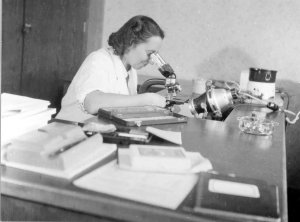 eighties. The original medical team has almost completely changed.
eighties. The original medical team has almost completely changed.
The separation of the faculties and the somewhat strained personal relations between the heads of the two institutes after the death of Professor Šikl meant that "pediatric pathology" was perceived at the Head of the Institute as an uncomfortable subtenant who should not be given too much. This was reflected, among other things, in the fact that the original scarce size of the allocated rooms did not increase in any way, even though the number of doctors and other staff increased. Even the new department of forensic medicine with two doctors, which was attached to the department at the beginning of 1964, was not given a separate room. In the small offices, there were only narrow aisles between the tables with microscopes and cabinets. There was not much less work than in the two older departments of the general faculty, especially when it came to the number of students and the number of autopsies. Regional children's autopsies were joined by others from the 1st and 2nd children's clinics in Karlov, the ÚPMD in Podolí, the maternity hospital in Londýnská and adult autopsies from some departments of the hospital in František, and later also from clinics in the Pod Petřínem hospital. There were significantly fewer biopsies.
It was lectured in the large lecture hall of the Institute of the Institute, because other subjects of the 3rd year also had their headquarters in the vicinity of Albertov. The teaching was focused on the pediatric direction, mainly general pathology according to Šikl's scripts was taught and special pathology was focused mainly on the interpretation of congenital developmental disorders. In addition to demonstrations of autopsies, free-standing macroscopic slides stored in characteristic-smelling preservative fluids were widely used in the practice.
Great care was given to the preparation of postgraduate clinicopathological seminars with pediatricians and especially with obstetricians, which took place regularly under the guidance of regional experts. The pathology of the perinatal period attracted the scientific interest of prof. Benešová since her assistant years. Unlike her teacher, however, she was not the type of researcher who had a hard time detaching herself from her microscope, she did not like to leave the library and considered meetings and seminars to be an unpleasant distraction from her scientific concentration. She was a born organizer and discussant, her resounding voice allowing her to handle any debate. Therefore, the seminars were usually very lively, sometimes even militant, and it was necessary that everyone, the clinician and the pathologist whose case was being discussed, was prepared to answer all possible questions.
Prof. Benešová soon took over - in addition to her work on the faculty committees and later in the Dean's Board - the important position of chairwoman of the Main Branch Committee for Morphology and Pathology at the Ministry of Health. She was also one of the initiators and founding members of the Czechoslovak and Czech Society of Pathologists, where she was a member of the executive committee for many years. She was also the organizer of the scientific congress of the Czech Society, which took place in 1962 in the Municipal House Na příkopech. After retiring, she was elected chairwoman of the Association of Czech Physicians for one term from 1973 to 1977.
Extensive organizational activities and a number of daily routine activities with numerous obstacles to an insufficiently equipped workplace have, of course, resulted in a lack of time for more extensive scientific activities. The vast majority of pediatric pathology publications concerned case studies of congenital malformations and only rarely minor thematic topics, mostly based on autopsy findings. Cooperation with developing pediatric cardiac surgery was undoubtedly of great importance. Clinicopathological studies based on biopsy findings were quite unique. The collaboration with several researchers was mainly based on histological verification of the expected changes in the organs of experimental animals.
Between 1954 and 1973, about 25 doctors gradually worked in pediatric pathology. The exact number is now difficult to determine, because a large part stayed in the institution for only 1-2 years, often in a crowd, and in addition, some doctors were "regional", ie the employer was the KNV medical branch, and part was "school". 16 were constantly involved in pathology, but half of them later moved to other workplaces. Two of them later habilitated in pathology (V. Rychterová, I. Haskovcová) and two in other fields (F. Kornalík, B. Suková).
In 1971, Professor Benešová reached the age limit of a university teacher, but she remained in the position of head of the department and the department in the school year 1972-73. This was not only a manifestation of the faculty's recognition of its undeniable merits in the past, but the main reason was the fact that it was difficult to find a follower. According to the personnel requirements of the time, he was to be primarily a member of the Communist Party and then an expert with pedagogical practice and experience in pediatric pathology. The management of the faculty quickly found out that it would hardly find such a candidate. The wave of emigration in 1968 brought three associate professors (of which two members of the Communist Party) and two pupils of prof. The Benešes who could be considered - J. Rokos and T. Klíma - moved to the west. The head of Motol pathology, Mayor M. Rauchenberg, also left in the same direction. Professor Benešová then supervised both workplaces for four years.
My current boss, prof. Cooper, the administrator of the Hlav's Institute, had an eminent interest in having the head of the second institute in the building someone he could get along with. After 15 years of cooperation, he thoroughly knew my tolerant nature and therefore urged me to take an interest in this position. However, the prospect of taking over the management of the institute after my former teacher did not appeal to me. I enjoyed my assistant work, I got along well with my students, I had a lot of time for research work, which I enjoyed. In addition, I was not convinced of my command skills. I was also able to critically observe the big difference in the equipment of both institutes and in the qualifications of their staff.
At that time, in addition to Professor Bednář, there were three associate professors and three other assistants at the 1st pathology with a 2nd degree attestation or a CSc degree. Three doctors had a second attestation for children and one former graduate student had a CSc degree. The seventies were still a time of developing electron microscopy, which attracted me very much and where I already achieved internationally recognized results. The first pathology had two excellent Japanese electron microscopes, equipped with an EM laboratory, an excellent histochemical workplace, and tissue cultures. In pediatric pathology, they recently introduced a histochemical methodology - with the help of Professor Lojda, who trained aspirant Dudorkin and one laboratory assistant. The histology lecture room of the 1st pathology was equipped with 22 new binocular microscopes Meopta model D, while the children's one had at least half of the old monoculars of various brands. Doctors also had a mixture of outdated models, mostly with an external light source. The furniture in the offices was a random collection of specimens that had long since been discarded elsewhere.
In the end, I was convinced by Professor Bednář's promise that I would continue to have an electron microscope, and by the prospect that the entire new campus in Motol would be completed in the near future, where our field could be developed at the appropriate level. Also prof. Benešová recommended that I take this position. She still considered me a little like her student, even though I felt she had not forgotten my "infidelity" nineteen years ago. In my mind, I hoped that in time I would be able to soften prof. Cooper to pass on at least one more room. However, I was disappointed in that, I did not ask for anything, much less on his successor, prof. Jirásek.
It so happened that one day in May 1972, I was sitting in the study of Academician Houšťek, Dean of the Faculty of Pediatrics, and I listened to what was expected of me when I took over the management of one of the important departments. As I later learned, his great ideal was integrated teaching, as introduced by McMaster University in Canada and Maastricht in the Netherlands. He promised to infect the new generation of teachers with his enthusiasm for this progressive but organizationally very complex way of teaching. However, there were too many objective reasons why this plan ended after several not very successful attempts at implementation.
I transferred to the Faculty of Pediatrics on March 1, 1973 as an assistant, so that, at the Dean's request, I would have half a year to get acquainted with the conditions at the new workplace. However, I remained seated in my old study because there was no vacancy in my future institution. I did not move to the mayor's office until the end of September, when prof. Benešová moved her pathology stuff to Motol. Almost at the same time, the new school year was already beginning.
The headmaster's large square study was certainly one of the most beautiful rooms in all of Albertov — if it were a view from the huge windows that occupied almost the entire south and west walls. Otherwise, it had a number of disadvantages - it was hot in the summer and cold in the winter. I didn't know that yet and I tried to make minor adjustments. The approach to the mayor was quite complicated: from the corridor, one entered through a small hall to another smaller room where doctors were sitting. The office was around the corner, so they kept running and had little peace of mind. So we moved secretaries here.
There was a lot of work going on for me. In addition to the daily autopsy and biopsy, they began to worry about teaching. The lecture didn't bother me much. I have been entrusted with some chapters in the first pathology for many years, under the strict supervision of Professor Bednář, who often sat in the last row of the auditorium and did not spare criticism over the content and formal aspects of the assistant's performance. In addition, I was in charge of an educational collection of many hundreds of slides, which I constantly supplemented and improved according to the detailed syllabi of my demanding boss. Although there were also a lot of slides in pediatric pathology, the quality was significantly worse and there were mainly gaps in the systematic documentation in many places. The syllabi mostly contained only chapter titles from the then textbook of pathological anatomy.
Every new leader has some difficulty enforcing his ideas in a new workplace. My situation was all the worse because I inherited almost exclusively a female team (assistants J. Čapská, V. Povýšilová, A. Zuntová, D. Dudorkinová, secondary D. Schlegerová, M. Čermáková, aspirant I. Zobanová). The only one of the eight medical positions was occupied by a man (A. Karpenko). As is well known, women tend to be more careful and hardworking than men, but they are very conservative in their habits, so organizational change is very difficult to enforce. Even more than doctors, I have observed this property in secretaries and laboratory technicians. In addition, in the next few years, I had the impression that a population explosion had broken out. About seven times I heard the embarrassing announcements of my co-workers that they were expecting a baby and that they were therefore not allowed to work in the autopsy or laboratory. Representatives on maternity leave were also mostly women, of whom only, as far as I can remember, became pregnant. In this state, when a large part of the medical team consisted of beginners, it was necessary to constantly check everything and deal with things that ran elsewhere on their own. More extensive research could hardly be imagined.
In this situation, a big blow to me was the warning of prof. Dobiáš, the chairman of the relevant commission, to whom I presented the concept of my doctoral thesis, that I cannot use as a substantial part of her the publication on ultrastructural changes of the glomerular basement membrane, which I just published in the prestigious "Laboratory Investigations". It was the result of my one-year stay in Chicago, and such work from foreign workplaces was not considered to be sufficient proof of the candidate's scientific potential.
Our medical team had another peculiarity: no one was a member of the Communist Party. It was often bitterly blamed on me during various inspections. One of the consequences was that I headed the department for an assistant's salary for two years before I received a decree to be appointed associate professor. On the other hand, I felt that this is why many faculty and especially students sympathize with us. In addition to leading pathology, I inherited from prof. Benešová also held the title of head of the department, which also included microbiology and forensic medicine. Related to this was the obligation to convene regular meetings with teacher training and to report to the dean's office. Due to the fact that the external head of microbiology doc. Potužník a soudní vedoucí as. Řehánek were in a similar situation, when it came to the staff, these meetings were usually brief and focused on practical issues rather than ideology, so the secretary of the department doc. Happy, usually pretty busy with reporting.
Even before my arrival, the position of the department changed somewhat, as the new monoblock of the children's hospital was finally completed and in 1971 the children's clinic moved to Motol. Clinical pediatric autopsies were then performed in Motol, where prof. Benešová worked for many years (from 1973 to the end of May 1991) as an ordinary for pediatric pathology. As a result, "pediatric pathology" remained virtually free of childhood autopsies and biopsies at the time of my appointment, with the exception of neonatal autopsies from several Prague and regional maternity hospitals.
In this situation, the decision of prof. R. Vaněček, who apparently expected an adverse impact of standardization personnel on his position as head of the 2nd Institute of Pathology and Anatomy and in 1974 he handed us autopsies and biopsies from Professor Tošovský's Department of Pediatric Surgery, which belonged to the Children's Faculty institute. We then enthusiastically solved many professional problems of mutual cooperation, with which we had little experience until then. This was especially true for their oncology department of Assistant Koutecký, who later became a pediatric oncology clinic thanks to him. However, for many years I had to divide my main professional interest, which until now was kidney pathology, especially in terms of biopsy diagnostics of internal diseases, also in pediatric oncology. Tumors in children are a very special and difficult chapter in biopsy, as many of them look like "small, dark, round cell tumors" on histological examination, even though they have completely different biological properties. However, distinguishing them is absolutely necessary for medical procedures. At that time, we did not yet have immunohistological methods, so deciding between different types of pediatric tumors was very difficult and required a lot of time and effort. Our cooperation was no longer interrupted by the relocation of the clinic to Motol in 1978, even though the great distance prepared both of our workplaces for a lot of time.
Our small team consolidated at the end of the seventies, all assistants passed the 2nd attestation and the other three defended the candidacy. After 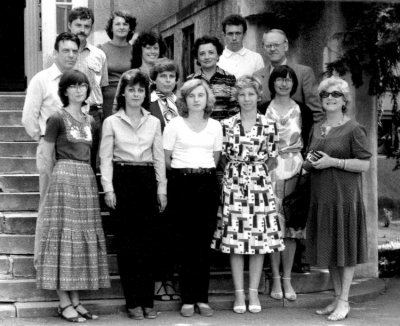 When Assistant Karpenko left for the primary position in Benešov, we were without a male member in the teaching staff for several years, until our persistent student collaborator R. Kodet graduated. He then continued with another postgraduate degree as an assistant professor, and after a candidacy and a one-year study stay at a well-known research center in Manchester, he achieved an associate professorship in 1988 as the first offspring in the entire history of pediatric pathology. Shortly after him, V. Povýšilová also got habilitated. The career advancement of my co-workers was a great relief for me, as I was able to transfer to them part of the exhausting work they present for each final exam leader. There were usually 130 to 160 students in a year, and with the usual 25-30% "mortality", the number of all probationary periods usually exceeded two hundred each year. To make it a little easier to work with endless testing, in the late 50s I developed several tests of multiple answers on 60 and XNUMX questions from various chapters of pathology and used them as an introduction to my own examination. The students did not like them, but they proved to be quite good for me in the overall assessment: the test result rarely differed from the end of the detailed oral examination. I stopped using them when there was a strict regulation that final exams can only be oral or only written. We then used their selection to stimulate academic morale during the year.
When Assistant Karpenko left for the primary position in Benešov, we were without a male member in the teaching staff for several years, until our persistent student collaborator R. Kodet graduated. He then continued with another postgraduate degree as an assistant professor, and after a candidacy and a one-year study stay at a well-known research center in Manchester, he achieved an associate professorship in 1988 as the first offspring in the entire history of pediatric pathology. Shortly after him, V. Povýšilová also got habilitated. The career advancement of my co-workers was a great relief for me, as I was able to transfer to them part of the exhausting work they present for each final exam leader. There were usually 130 to 160 students in a year, and with the usual 25-30% "mortality", the number of all probationary periods usually exceeded two hundred each year. To make it a little easier to work with endless testing, in the late 50s I developed several tests of multiple answers on 60 and XNUMX questions from various chapters of pathology and used them as an introduction to my own examination. The students did not like them, but they proved to be quite good for me in the overall assessment: the test result rarely differed from the end of the detailed oral examination. I stopped using them when there was a strict regulation that final exams can only be oral or only written. We then used their selection to stimulate academic morale during the year.
On the other hand, I had to end the years of collaboration with the nephrologists of the Central Military Hospital and to a large extent reduce the scope of examinations for the nephrology department of the 2nd Internal Clinic of the General Hospital. However, I was able to continue working with pediatric nephrologists from Motol and the Pod Petřínem Hospital. Thanks to the understanding of prof. We were still able to use their electron microscopes for cooper cooperators. However, most of our doctors did not stick to them. For this, one of them - D. Schlegerová - managed to enrich our methodological spectrum with immunofluorescence technique after a great effort.
The teaching schedule was adapted to the new location of the institutes and clinics in order to reduce the time lost by students when moving from one auditorium to another. For about two semesters we had to lecture in a less suitable auditorium at the Pod Petřínem Hospital. Finally, in the late XNUMXs, new auditoriums began to be used in Motol. The content of teaching had to be gradually changed and expanded, because the profile of the graduate was defined much more broadly than when the faculty was established, it differed from general faculties only by emphasizing the developmental aspect. Since the end of the XNUMXs, the teaching of pathology has not differed much - in terms of scope and content - from teaching at other faculties.
To everyone's surprise, our 11th European Congress of Pathologists in 1987 had almost a thousand mostly foreign participants in the House of Culture. 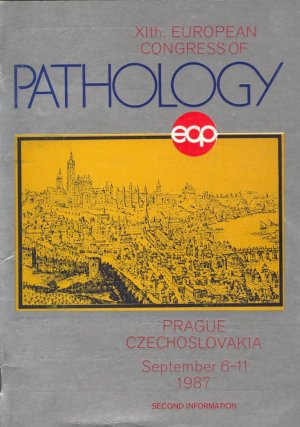 Telling about the many pitfalls of the organization is incredible for the younger generation today and is more like anecdotes. E.g. the printers of the time were unable to meet any deadlines. The first announcement was made a week after my train departure for the 10th Congress in Athens. I did not receive them by air until the middle of the congress, when it was difficult to distribute them to all participants. The second announcement was also two months late, so it arrived in some countries just before the deadline, so we suspected we wanted to get an increased fee. However, a bigger surprise awaited our guests on the spot, when instead of the expected disaster, everything ran - except for a few little things - completely smoothly. The social program, which surpassed everything at previous company congresses, was particularly successful. The successful congress brought us many recognitions and numerous friendships of foreign colleagues. I was then a member of the executive committee for several years, which granted me an honorary membership in 1993.
Telling about the many pitfalls of the organization is incredible for the younger generation today and is more like anecdotes. E.g. the printers of the time were unable to meet any deadlines. The first announcement was made a week after my train departure for the 10th Congress in Athens. I did not receive them by air until the middle of the congress, when it was difficult to distribute them to all participants. The second announcement was also two months late, so it arrived in some countries just before the deadline, so we suspected we wanted to get an increased fee. However, a bigger surprise awaited our guests on the spot, when instead of the expected disaster, everything ran - except for a few little things - completely smoothly. The social program, which surpassed everything at previous company congresses, was particularly successful. The successful congress brought us many recognitions and numerous friendships of foreign colleagues. I was then a member of the executive committee for several years, which granted me an honorary membership in 1993.
We were increasingly annoyed that we did not belong to the Motol University Hospital in terms of health, but traditionally to the KÚNZ, even though the "regional autopsies" of children were already exceptional due to the establishment of many pathologies in district hospitals. I did not have a medical representative for many years, although I repeatedly asked the directorate. During negotiations at a lower level, we often heard sentences in the sense: "You do not work for us, so what do you want money from us ..." Administrative transfer under the administration of Motol was successful only after the November Revolution (from 1.10.1991), but closer cooperation with the local clinical disciplines - with the exception of pediatric oncologists, cardiologists and nephrologists, we still lacked. The clinics at Pod Petřínem Hospital were very cooperative, but also too distant.
We could see the beginning of the Velvet Revolution from the windows as large crowds of determined students gathered in front of the Main Institute. Two of our doctors walked with them to Národní třída. In the following days, a lot of effort was devoted to writing and reproducing leaflets on our new copier, which we happened to receive a few days ago. The enthusiasm for easing has made some of us have a foothold in public life. Mayor Schlegerová worked for several years as a deputy in her district in Prague 1. I became a member of the presidium of Purkyň's society for one term.
However, in the first year after the revolution, we were again under great pressure to finally relocate to Motol. There were several unpleasant negotiations with the management of the general medical faculty, where I had to convince academic officials that the relocation of the institute to Motol did not depend on me, but on when the construction of the hospital was completed. She seemed out of sight for a long time. In addition, pathology with forensic medicine was to be located away from the main building in the new building, which was only in rough plans so far. The main argument for our eviction was the planned renovations in the building. I took this warning seriously because we had already experienced several reconstructions and it always represented a number of inconveniences, hard work and delays at work.
The long-awaited replacement of radiators and risers for better hot water heating took place in our part of the building in January. It was complicated by a small fire in our museum. Renovation of the plaster of the entire building was associated with the replacement and painting of windows, which also took place in our very cold part of the year. We were also affected by the replacement of water risers, followed by a short period of rest by the reconstruction of the gas pipeline. Now there was a threat of electrical voltage conversion. All reconstructions were carried out at full operation, which was maintained with all effort. Usually, in addition to the unimaginable clutter and work of moving overcrowded rooms, they also brought us the loss of some of our equipment, such as the only showers for employees (technical difficulties?), Gas stoves in the laboratory (safety) and in our histology auditorium (ran out of money). but usually I had the impression that it was just a form of coercion to speed up our move to Motol.
That is why I have repeatedly negotiated with the Motol headquarters about the possibility of modifying an old pavilion for our purposes. I seemed to succeed and get the renovated ground floor building of the maternity hospital, but in a few months our hopes were dashed. A few weeks before I retired, I submitted another of several reports with documents for other new construction projects.
Uncertainty about the future of our institute has manifested itself in a certain nervousness among employees. In the penultimate year of my preference, two assistants - Dr Dudorkinová and Dr Julišová - gradually informed me that they would go to other, more promising places for them. Fortunately, by the beginning of the 1991-92 school year, we had a new assistant - Dr. Soukup, who already had some teaching experience, and the second place was shared by older secondary students. What was worse was that four experienced laboratory technicians had resigned at the same time as the doctors, so that for several months the entire burden of the operation rested on the remaining dedicated workers before the new forces worked a little harder.
At the end of 1992, my stage in running the institute ended and I handed over - quite with a clear conscience - a symbolic scepter to my successor Roman Kodet, wishing he could build the institute according to his ideas, which I was not allowed to do. However, the change of managers was also connected with the exchange of offices and the necessary moving to a room with an area of less than 6 m2, which my successor once modified on his own from the former washroom. Of course, I could only put the most necessary instruments and books there. Nevertheless, I stayed there for another five years.
Soon after, our situation at the Head Institute improved considerably after he was appointed building manager prof. Miřejovský, who showed a greater understanding for our difficult situation and left us the room of the canceled chemical laboratory. The relocation of forensic medicine to the former military facilities in Motol (hence later to Bulovka) also helped us. Finally, we were able to set up new doctors, for whom we had no place until now, and who resided with the kindness of prof. Hořejší in a rented room at the gynecological clinic in Londýnská street. However, when the reconstruction of the power line broke out in 1992, I used their own hospitality for several weeks, because there was a godly allowance in Albertov.
The release of international relations took place immediately after the November Revolution - we received not only invitations to attend various scientific meetings in neighboring countries, but also offers of material assistance. E.g. we brought some excellent new ones from Vienna microtomes and dozens of microtome knives, which we shared with some minor pathologies. In 1993, we established our own International Academy of Pathology in our field. Despite the number of obstacles in our day-to-day operations, we further expanded our range of diagnostic methods. Immunohistology was the number one. In the mid-1993s, we had little quality antisera, so at first the diagnostic yield was low, but when R. Kodet returned with experience (as well as several samples) from England, the usefulness of this method began to prove. To this end, he negotiated a six-month internship with Assistant Soukup at his old acquaintances in Manchester in 1994 and, upon his return, hired a new employee - a graduate of the Faculty of Science familiar with PCR methodology. With the financial support of the Department of Pediatric Oncology, PCR was first tested in XNUMX for closer to neuroblastoma and later, with other workers, to distinguish between different types of malignant lymphomas.
microtomes and dozens of microtome knives, which we shared with some minor pathologies. In 1993, we established our own International Academy of Pathology in our field. Despite the number of obstacles in our day-to-day operations, we further expanded our range of diagnostic methods. Immunohistology was the number one. In the mid-1993s, we had little quality antisera, so at first the diagnostic yield was low, but when R. Kodet returned with experience (as well as several samples) from England, the usefulness of this method began to prove. To this end, he negotiated a six-month internship with Assistant Soukup at his old acquaintances in Manchester in 1994 and, upon his return, hired a new employee - a graduate of the Faculty of Science familiar with PCR methodology. With the financial support of the Department of Pediatric Oncology, PCR was first tested in XNUMX for closer to neuroblastoma and later, with other workers, to distinguish between different types of malignant lymphomas.
The year 1994 brought an important novelty in our pedagogical work: the teaching of foreign students in English began. At the beginning, I also helped with the seminars, but later it turned out that the language skills of our assistants are already sufficient for this work.
The next year saw another historic event: the merger of the Department of Pathological Anatomy and the Department of Pathology of the Motol Hospital of Primary V. Zeman under one roof - so far only symbolic.
The move to the new headquarters on the 2nd floor of the huge "blue pavilion" of the Motol Hospital began in the first week of January 1998, when we received the keys to the new rooms and in mid-February we ceremoniously handed over the keys to all rooms we remember - despite the various adversities experienced there, with a considerable dose of sentimentality, and we remember its pleasant aspects. Among them was the atmosphere of a quiet university district with gardens and parks surrounded by the sights of old Prague. Winter sunrises over Karlov, views of the snowy or flowering hillside below Apolinář and the old maternity hospital, distant views of Vyšehrad and the hills above Smíchov - these were everyday joys that cannot be forgotten.
Contact
Priority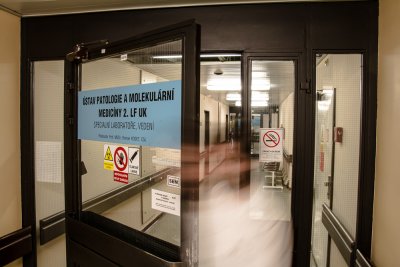 ta
ta
Prof. MD Josef Zámečník, Ph.D.
tel .: (224) 435 635
Primary
MUDr. Petr Skapa, Ph.D.
tel .: (224) 435 623
Chief laboratory assistant
Vladimíra Kratinová
tel .: (224) 435 626
General contacts
tel .: (224) 435 601
fax: (224) 435 620
Email: patologie@fnmotol.cz, patologie@lfmotol.cuni.cz
Location
- Institute management and biopsy operation - monoblock for adults, node A, 2nd floor
- Autopsy tract - pavilion no. 11, information on tel. 224 435 608
